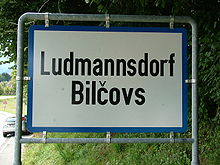Minority languages of Austria
| Languages of Austria | |
|---|---|
 A bilingual sign in Ludmannsdorf | |
| Minority | |
- Romany in Burgenland,
- Czech and Slovak in Vienna,
- Hungarian in Burgenland and Vienna, and
- Slovene in Carinthia and Styria.[1]
The
In the view of the representatives of the speakers of minority languages, however, the federal laws concerning regional or minority languages, as well as the Austrian application of the European Charter for Regional or Minority Languages, remain too restrictive.[3]
Official Minority Languages
Croatian

A group of
Like the
Slovene

The
During the time of the Socialist Federal Republic of Yugoslavia its authorities and authorities of constituent Socialist Republic of Slovenia and Socialist Republic of Croatia were involved in a series of disputes over the treatment of ethnic minorities in Austria.[8] Slovenian dissatisfaction was caused by differences in interpretation of the Austrian State Treaty as well as the decision by Carinthian authorities to end compulsory bilingual schooling in 1958.[8] In April 1971 the Slovene "Contact Committee" expressed their dissatisfaction in a memorandum to the Austrian Chancellor Bruno Kreisky in which they listed requests for specific measures for the protection of the Slovene language.[8] On 11 November 1976 approximately 150,000 people in Ljubljana participated in an officially sponsored protest in solidarity with the Slovene community.[8]
See also
- Languages of Austria
- Demographics of Austria
- Burgenland Croats
- Carinthian Slovenes
- Czechs in Austria
- Slovaks in Austria
- Romani in Austria
- Vlax Romani language
References
- ^ Federal Chancellery of Austria. Retrieved 16 August 2015.
- ^ Federal Ministry for Europe, Integration and Foreign Affairs. Retrieved 16 August 2015.
- ^ "EUROPEAN CHARTER FOR REGIONAL OR MINORITY LANGUAGES-APPLICATION OF THE CHARTER IN AUSTRIA 3rd monitoring cycle" (PDF). Council of Europe. Retrieved 16 August 2015.
- ^ "gradišćanski Hrvati | Hrvatska enciklopedija". Enciklopedija.hr. Retrieved 2017-03-10.
- ^ "Bevölkerung 2001 nach Umgangssprache, Staatsangehörigkeit und Geburtsland" [Population 2001 by colloquial language, nationality and country of birth] (in German). Archived from the original on 6 June 2012.
- ^ S2CID 143561008.
- ^ S2CID 189880584.
- ^ JSTOR 40867905.
